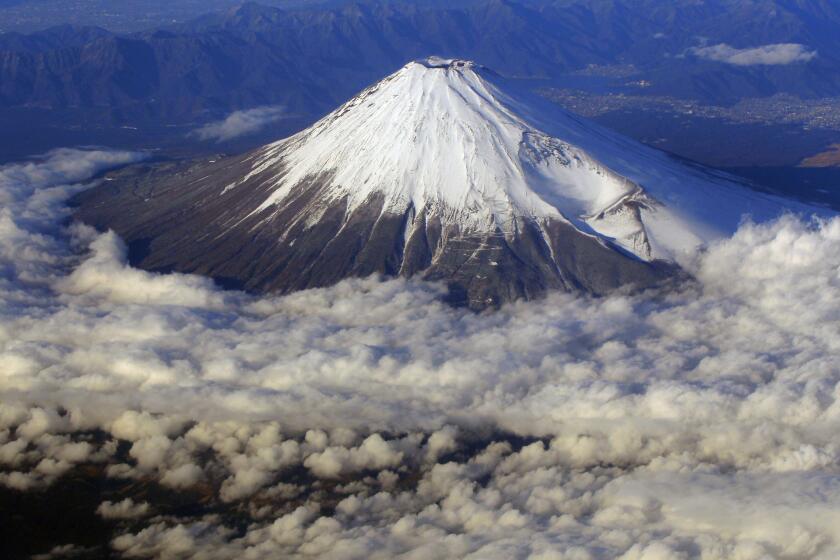Flying faster than Jules Verne
EVERYONE told me the world is round. But last month I had to find out for myself.
I started in Paris and flew east to Nepal by way of Bahrain on Gulf Air. From Katmandu, Nepal’s capital, I took Royal Nepal Airlines to Bangkok, Thailand, then Thai Airways to Chiang Mai in the northern part of the country and back.
In Bangkok, I caught a Cathay Pacific flight to Los Angeles, changing planes in Hong Kong. Then I flew Alaska to Washington, D.C., and United back to Paris.
Before I made my booking, I priced round-trip tickets to Bangkok and L.A., two of my desired destinations, which were running about $1,800 and $1,000, respectively, from Paris. I also investigated special around-the-world fares and passes offered by airlines, which were attractively priced but unworkable given my route and time frame.
A colleague told me about Airtreks (www.airtreks.com), a San Francisco-based travel agency that specializes in around-the-world trips, and in just a few e-mail exchanges I succeeded in nailing down an itinerary. The grand total of $2,805 was about the same as the combined fare for back-and-forth flights from Paris to Bangkok and from Paris to L.A., but it also included Katmandu, Chiang Mai and Washington, D.C.
“Fewer people qualify for air passes or published around-the-world airfares than think they do,” Airtreks vice president Tom Michelson said. For that reason, agents at Airtreks generally customize around-the-world itineraries from a series of point-to-point tickets, combining flights operated by different carriers on the same ticket to maximize convenience and minimize cost.
Besides getting me where I wanted to go, my circumambulation taught me some interesting lessons. Gulf Air, for instance, flies to such global hot spots as Tehran and Damascus, Syria. In the Persian Gulf island kingdom of Bahrain, capitalism seems to have inspired some sort of religious or cultural tolerance, based on the Christmas trees and Santas I saw at its airport shopping concourse.
Airports everywhere have morphed into malls to distract travelers during layovers, suck the left-over foreign currency out of their wallets and make sure they board crowded planes with a stuffed carry-on bag.
I like to shop, but the merchandize at duty-free boutiques was mind-numbingly uniform everywhere: cigarettes, booze, Toblerone chocolates, Hermes scarves, Lancome wrinkle cream, Swatch watches. After a while I felt like the lead character in “Evening Primrose,” an early Stephen Sondheim musical about a man who lives in a department store. (The show’s best song starts, “I remember sky.”)
It takes only a glance at a globe to see that Asia is closer to Europe than to North America, but I had to substantiate that too. All told, it took about 10 hours, excluding the layover in Bahrain, to get from Paris to Katmandu, whereas flying from L.A. to the Nepalese capital would have taken at least twice that, not including a stopover somewhere.
More significantly, Nepal is only about five hours ahead of Paris, a relatively easy adjustment, but 14 hours ahead of L.A. (ignoring the International Date Line). That’s more than enough time to discombobulate anyone’s circadian rhythms.
I blame railway engineer Sandford Fleming for this sore test of a traveler’s mettle. Localities used to set their own time, according to the sun, until the 1870s when Fleming came up with the idea of dividing the world into 24 standardized time zones, partly to avoid train schedule confusion. Now it’s travelers who get confused crossing his blasted zones.
Helen J. Burgess, assistant director of the Biological Rhythms Research Laboratory at Chicago’s Rush University Medical Center, said that if you stayed at least a week in each destination, a trip like mine might not be so bad. But traveling east around the world is worse in terms of jet lag than going in a westerly direction.
“We have a natural biological tendency to go to bed and get up later every day. So flying west helps us get readjusted, but heading east is like going against the tide,” Burgess said.
Had she been in my place, Burgess told me, she would have started trying to reset her internal clock several days before departure by going to bed and getting up an hour earlier each day. A small amount of melatonin -- say .5 milligrams -- taken five hours before bedtime can aid the process.
“But when you take melatonin is crucial. If you take it at the wrong time it can make matters worse,” Burgess said.
I went the wrong way around the world with no melatonin -- just eye shades, ear plugs and a hand sanitizer to fight cold bugs.
I was surprisingly jet lag-free for the first half of my trip, partly because I stayed a week in Katmandu and Chiang Mai. But after the 12 1/2 -hour flight from Hong Kong to L.A., with a time change of 16 hours, I was a zombie. To make matters worse I stayed in L.A. for only two days and came down with a cold by the time I reached Washington.
I had a nice Thanksgiving there but could barely keep my head from falling into the pumpkin pie.
Looking back on it though, the layovers -- six hours in Bahrain, five hours in Bangkok, four hours in Hong Kong -- were the worst, especially because I don’t have any airline club memberships. But these days many big airports have private lounges passengers can use for a fee, which was worth it to me.
The Dilmun club in Bahrain had great appetizers; the CIP Lounge in Bangkok lacked adequate air-conditioning and bathroom facilities but at least had comfortable places to sit, unlike the rest of new Suvarnabhumi International Airport; and at one of Hong Kong airport’s Premium lounges I took a shower and catnapped in a curtained cubicle.
Travelers often can use airline lounges if they fly first or business class or are willing to pay for the privilege. I upgraded my Alaska Airlines ticket from economy to first class for a reasonable $100, assuming it would get me into the carrier’s club. But upgraded tickets don’t open lounge doors, I discovered. So I spent $30 more to kill time in Alaska’s lounge, a good thing since my flight to D.C was delayed by more than an hour.
Later, I spent frequent-flier miles to use United’s Red Carpet Club at Washington Dulles International Airport, which I did not regret because the attendant took the trouble to change my seat assignment, putting me in an empty row of five seats. Being able to stretch out made the 7 1/2 hours it took to get to Paris fly by.
I got home early one Sunday, 26 days after I’d left. I was grubby and groggy. I couldn’t remember anything much about Katmandu. I vaguely recall going to the office in L.A. and playing Scrabble with my family at Thanksgiving in Washington.
But I’m quite sure Columbus was right. The world is round. I should know.
*
Sign up for The Wild
We’ll help you find the best places to hike, bike and run, as well as the perfect silent spots for meditation and yoga.
You may occasionally receive promotional content from the Los Angeles Times.



